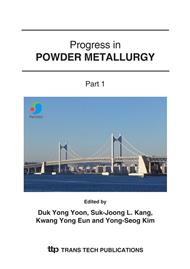p.897
p.901
p.905
p.909
p.913
p.917
p.921
p.925
p.929
Preparation of Warm Compacted NbC Reinforced Iron-Based Composite and Its Tribological Behavior
Abstract:
A 15 wt.% NbC particulate reinforced iron-based composite was prepared by using warm compaction PM technique. It possesses a high relative density of 98%, a tensile strength of 515 MPa, a hardness of HRC 58 and a remarkable tribological behavior. Warm compaction was used because it can provide compacts with high green density and also increase the formability of the mixed powder. Furthermore, it can provide green strength that is strong enough to handle compacts before sintering. Block on ring tribotester was employed to study the compact’s friction and wear behavior using GCr15 steel as counterpart. A load of 980 N was used. The friction coefficient was 0.085 when the number 20 engine oil as lubricant was used. The results showed that the sintered composite has excellent wear resistivity. This material was then applied in the valve-guide cup of a combustion engine and subject to 500 hour bench test. The cup showed good performance for this test and did not shown any severe wear on the working surface after the test was completed. Therefore, it is a suitable material for parts that are exposed to severe wear condition.
Info:
Periodical:
Pages:
913-916
Citation:
Online since:
January 2007
Authors:
Price:
Сopyright:
© 2007 Trans Tech Publications Ltd. All Rights Reserved
Share:
Citation:


